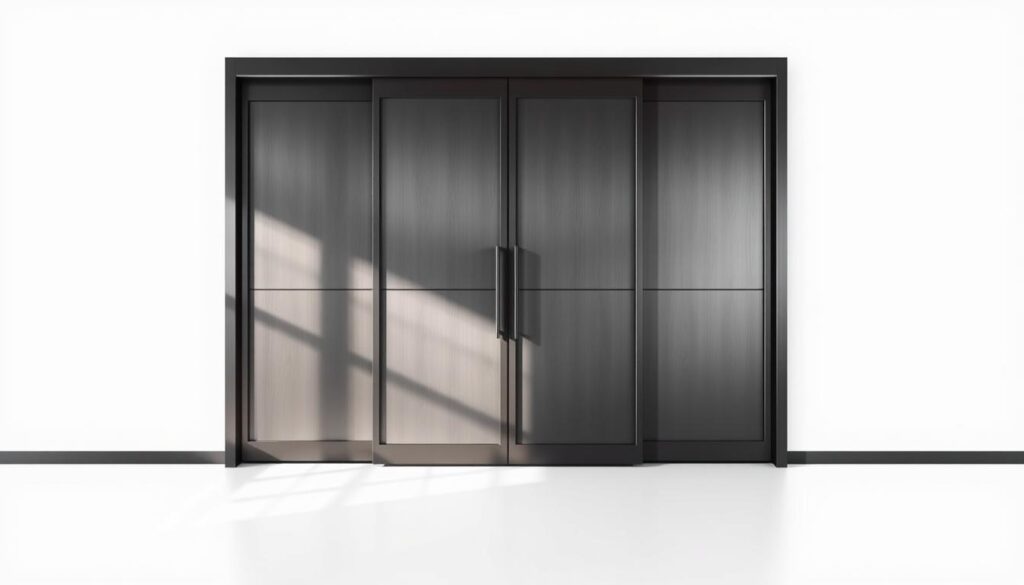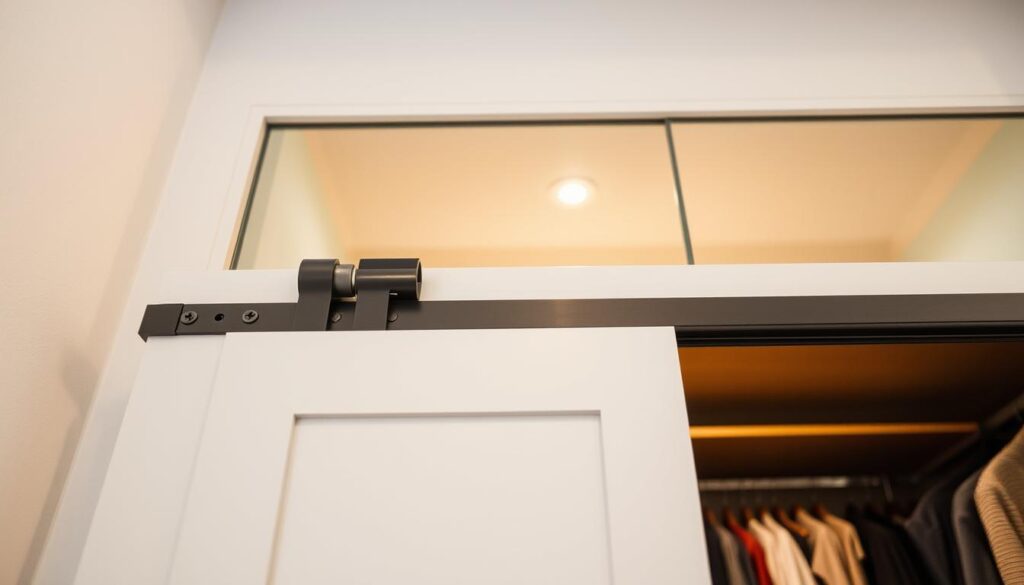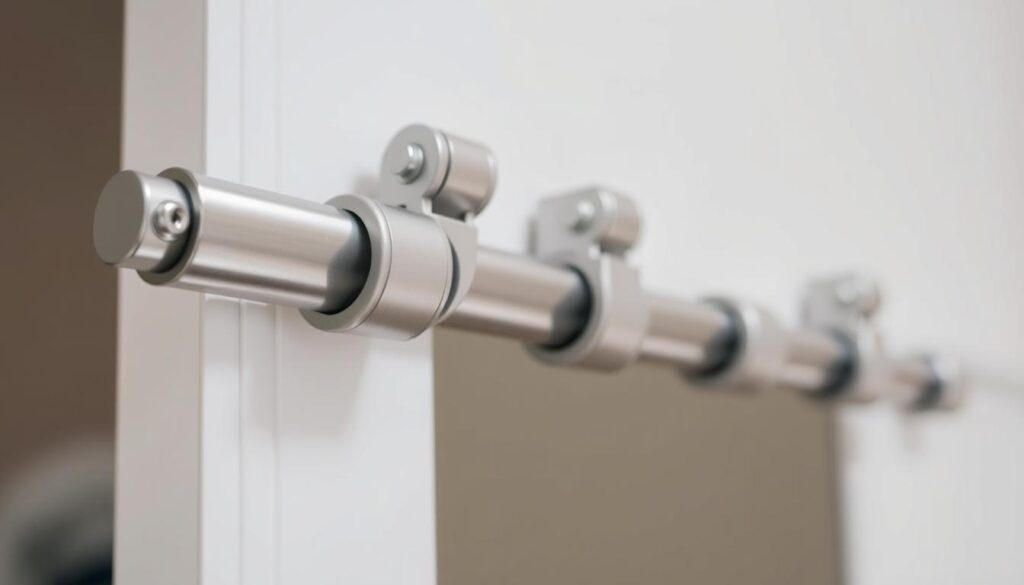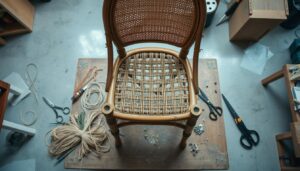Are your sliding wardrobe doors becoming increasingly difficult to open and close? This frustrating issue is often caused by worn-out or damaged wheels or rollers. Fortunately, replacing these components is a relatively straightforward DIY task that can restore smooth operation to your wardrobe doors.
Replacing the rollers on your sliding wardrobe can seem daunting, but with the right guidance, it’s a manageable task. In this article, we’ll walk you through the process, covering different types of sliding door mechanisms and providing step-by-step instructions for both steel-framed and aluminium-framed wardrobe doors.
Key Takeaways
- Identify the type of sliding door mechanism in your wardrobe.
- Safely remove your wardrobe doors for maintenance.
- Replace both top guide wheels and bottom running wheels.
- Reinstall your doors with proper alignment.
- Extend the life of your sliding wardrobe system with DIY repairs.
Understanding Sliding Wardrobe Door Rollers
Sliding wardrobe doors rely on rollers to glide smoothly along their tracks, making these components crucial for their operation. The sliding rollers/wheels that allow sliding doors to run smoothly in their tracks can be manufactured from different materials and work in different ways.
Types of Sliding Door Rollers
Different types of sliding door rollers are available, catering to various door systems. Top guide wheels typically feature spring-loaded mechanisms that maintain contact with track walls, while bottom running wheels bear the door’s weight. Quality rollers often use proper bearings, such as 608zz double-shielded bearings rated ABEC-5, rather than simple plastic pegs, providing smoother operation and a longer lifespan.
Signs Your Rollers Need Replacement
You may need to replace your wardrobe door rollers if you notice doors that stick, make grinding noises, jump off tracks, or require excessive force to move. Visible damage such as cracked wheels, worn rubber coatings, or wheels that no longer rotate freely are also indicators that replacement is necessary. Understanding your door construction, whether it’s steel-framed or aluminium-framed, is essential before purchasing replacement parts, as different door types require specific roller designs.
Tools and Materials Needed
To replace your wardrobe sliding door rollers, you’ll first need to assemble the required tools and components. Having the right equipment will make the process smoother and more efficient.
Essential Tools for the Job
You’ll need basic tools including a screwdriver set (both Phillips and flathead), pliers, a small hammer, and potentially an Allen key set depending on your door design. A measuring tape will help you confirm the dimensions of replacement parts.
Replacement Parts Selection
When selecting replacement parts, it’s crucial to match your existing roller system precisely. For steel-framed doors, you’ll typically need nickel-plated steel carriages with PVC inserts and rubber-coated dual wheels for top guides. Aluminium-framed doors require different roller assemblies, often featuring spring-mounted bottom rollers.
Safety Precautions Before Starting
Before you start replacing your sliding wardrobe door rollers, it’s crucial to take necessary safety precautions. Ensuring your safety and the success of the replacement process requires careful planning and preparation.
Handling Heavy Doors Safely
When dealing with wardrobe doors, especially those with glass or mirrored panels, it’s essential to have a helper. These doors can be significantly heavier than standard ones, and managing them alone can be risky. Wear protective gear like gloves to safeguard your hands from sharp edges and safety glasses if you’re working with metal components that might splinter.
Workspace Preparation
Clear the area in front of the wardrobe completely, removing any furniture, rugs, or objects that might cause tripping hazards or obstruct your movement. Prepare a safe place to lay the removed doors, such as a bed covered with a blanket or several towels on the floor. Ensure children and pets are kept away from the work area to avoid accidents.
| Safety Measure | Description |
|---|---|
| Helper | Have someone assist you with handling heavy doors. |
| Protective Gear | Wear gloves and safety glasses to protect against sharp edges and splinters. |
| Clear Workspace | Remove any objects that could cause tripping or obstruct movement. |
| Safe Placement | Prepare a safe area to lay removed doors to prevent damage. |
By following these safety precautions, you can ensure a safe and successful replacement process for your sliding wardrobe doors.
How to Identify Your Wardrobe Door Type
To replace your sliding wardrobe door rollers effectively, you first need to determine the type of door you’re dealing with. The main types are steel-framed and aluminium-framed doors, each with distinct characteristics and roller systems.
Steel-Framed Doors
Steel-framed wardrobe doors are typically characterized by their robust appearance and substantial weight. They often feature thicker, heavier frames with visible corner joints. A key identifying feature is the presence of a stamped steel top-hung adjustable roller bracket, which also acts as a corner bracket for the door structure. These doors usually have a load capacity of up to 30kg per wheel.

Aluminium-Framed Doors
In contrast, aluminium-framed doors are generally lighter with sleeker, more modern profiles. They often feature spring-mounted bottom rollers that prevent the door from leaving the track. Aluminium systems typically have a higher load capacity (up to 50kg per wheel) despite their lighter appearance. The mounting systems for these doors involve rollers sliding into channels rather than being screwed directly to the frame.
| Door Type | Characteristics | Load Capacity |
|---|---|---|
| Steel-Framed | Thicker frames, visible corner joints, stamped steel top-hung adjustable roller brackets | Up to 30kg per wheel |
| Aluminium-Framed | Lighter, modern profiles, spring-mounted bottom rollers | Up to 50kg per wheel |
If you’re unsure about your door type, you can check any documentation that came with your wardrobe or take clear photos of your existing roller system to match with replacement parts. Correctly identifying your wardrobe door type is crucial for purchasing the right replacement rollers, as steel-framed and aluminium-framed doors use different roller systems and mounting mechanisms.
Removing the Sliding Wardrobe Door
The first step in replacing your wardrobe’s sliding-door rollers is to remove the door. This process requires careful handling to prevent damage to both the door and the track system, especially if the door is heavy, such as those with glass or mirrored panels.
Step-by-Step Door Removal Process
To remove a sliding wardrobe door, start by positioning it in the fully closed position. Then, grip the door firmly on both sides and lift it upward to clear the bottom track while keeping it vertical. Once the bottom edge is free, tilt the lower portion of the door toward you and carefully lower it out of the top track.
Where to Place the Door During Repairs
After removal, place the door on a soft, flat surface, such as a bed or a blanket-covered floor, with the interior side facing upward. This will give you access to the roller mechanisms. For heavier doors, consider having a helper to support both sides during removal to prevent accidents.
| Removal Step | Action Required |
|---|---|
| 1. Position Door | Move the sliding wardrobe door to the fully closed position. |
| 2. Lift Door | Lift the door upward to clear the bottom track. |
| 3. Tilt and Lower | Tilt the lower portion of the door toward you and lower it out of the top track. |
How to Replace Wardrobe Sliding-Door Rollers
Replacing the sliding-door rollers on your wardrobe is a straightforward process that can be completed with a few simple tools. The replacement process varies depending on whether you have steel-framed or aluminium-framed doors.
Replacing Top Guide Wheels
For steel-framed doors, you’ll need to locate and remove the screws securing the roller assembly to the door frame. Then, install the new unit in the same position using the original screws. Ensure the rubber-coated dual wheels are properly aligned to run smoothly within the steel top track channels.
For Steel-Framed Doors
Unscrew the screws holding the wheel in place and replace the old unit with the new one.
For Aluminium-Framed Doors
Loosen the screw in the side of the frame, and the top wheel will slide out. Replace the wheel and then re-tighten the screw.
Replacing Bottom Running Wheels
For steel-framed doors, locate the screws holding the wheel unit in place, remove them, and swap in the new wheel assembly. For aluminium-framed doors, identify the two holes in the bottom framework and unscrew the lower screw to replace the bottom wheel unit.
For Steel-Framed Doors
Remove the screws completely, swap in the new wheel assembly, and reattach using the original screws.
For Aluminium-Framed Doors
Fully unscrew the lower screw, allowing the wheel unit to fall out, then insert the new wheel and re-tighten the screw carefully.
Reinstalling the Wardrobe Door
Reinstalling your sliding wardrobe door requires precision to ensure it operates smoothly. This process involves careful handling and alignment to prevent damage to the newly replaced roller system.
Proper Alignment Techniques
To reinstall the door, begin by positioning it at an angle, with the top edge tilted toward the wardrobe, and guide the top rollers into the top track first. Ensure the bottom edge is clear of the bottom track. Once the top rollers are seated, straighten the door and lower it so the bottom wheels engage with the bottom track.

Testing Door Movement
After reinstalling, test the door movement by sliding it slowly along the track. Check for any resistance or unusual noises that might indicate misalignment. Ensure both top guide wheels are fully seated and the door stands perfectly vertical. Make any necessary height adjustments using the adjustment screws on the bottom wheels to ensure smooth operation.
Verify that multiple doors overlap correctly and can move freely without catching on adjacent doors or the wardrobe frame. This final check ensures your sliding wardrobe doors are functioning as intended.
Troubleshooting Common Issues
To achieve optimal performance, troubleshooting common issues with your sliding wardrobe doors is necessary after roller replacement. Even with new rollers, some problems may persist.
Door Not Sliding Smoothly
If your wardrobe door isn’t sliding smoothly, check for debris in the track, ensure the wheels are properly seated, and verify that the wheels themselves aren’t damaged or improperly installed.
Door Jumping Off Track
A door that jumps off its track usually indicates either improperly installed anti-jump mechanisms or bottom wheels that aren’t correctly aligned with the track. Check that the bottom wheels are fully engaged with the track.
Adjusting Door Height
Height adjustment is crucial for proper door operation. To adjust the door height, locate the adjustment screws on the bottom wheel assemblies and turn clockwise to raise the door or counterclockwise to lower it.
| Issue | Cause | Solution |
|---|---|---|
| Door not sliding smoothly | Debris in track, damaged wheels | Clean track, inspect and replace wheels |
| Door jumping off track | Improperly installed anti-jump mechanisms, misaligned bottom wheels | Check and adjust anti-jump mechanisms, align bottom wheels |
Maintenance Tips for Sliding Door Rollers
The key to extending the life of your sliding wardrobe doors lies in proper maintenance. Regular upkeep ensures that the doors continue to operate smoothly and efficiently.
Cleaning Practices
To keep your wardrobe door rollers in good condition, establish a regular cleaning routine. Use a vacuum cleaner with a narrow nozzle attachment to remove dust and debris from both top guides and bottom tracks. Pay special attention to the areas where wheels make contact. After vacuuming, wipe tracks with a slightly damp cloth to remove any remaining dust, then dry thoroughly to prevent moisture damage to metal components.
Preventative Measures
In addition to regular cleaning, several preventative measures can be taken to ensure the longevity of your sliding wardrobe door system. Apply a small amount of silicone-based lubricant to the tracks occasionally, wiping away any excess to prevent attracting more dust. Consider installing door stoppers to prevent doors from being pushed beyond their normal range of movement, which can damage rollers or cause doors to jump tracks. For more detailed information on maintaining your sliding door system, you can refer to our guide on sliding glass door roller replacement.
Conclusion
The process of replacing wardrobe sliding-door rollers is straightforward and rewarding. By following the step-by-step guide, you’ve gained the knowledge to identify your door type, select the right replacement components, and install new rollers for smooth operation.
To ensure the longevity of your newly replaced rollers, remember that proper maintenance is key. Regular cleaning and careful use will keep them functioning optimally. For persistent issues, consider consulting a professional or contacting the manufacturer for specialised advice.
With your sliding wardrobe doors now operating smoothly, you can enjoy improved accessibility to your storage space. For additional information or to purchase replacement components, contact reputable suppliers who specialise in wardrobe door hardware.



